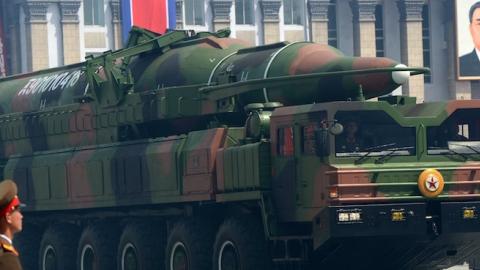Does the brutal, provocative and nuclear-armed North Korean regime actually pose a threat to the United States?
In recent weeks, Pyongyang has increased the seriousness of its threats to include preemptively attacking with nuclear weapons both the United States and South Korea during the allies’ annual joint military exercises. This comes on the heels of North Korea’s fourth underground nuclear explosion and yet another long-range missile test in the form of a satellite launch.
Perhaps its most concerning missile is the mobile KN-08, which Admiral William Gortney, the commander of Northern Command, recently testified before Congress could deliver a nuclear weapon to much of the continental United States.
Although the regime leader is in the habit of making empty threats, the United States cannot afford to bank on the hope Kim Jong-un is crying wolf.
Analysts who view international relations with a rosier, more idealist outlook remain skeptical. They try to tamp down such ominous threat analyses like that of Admiral Gortney’s, and are quick to point out that the regime has yet to actually prove it has mastered the ability to deliver a long-range missile.
It is true North Korea has yet to demonstrate a technically challenging part of a missile launch — when the reentry vehicle reenters the atmosphere as it descends upon the desired target — or that it can accomplish this feat with a weighty nuclear payload atop. But it has demonstrated enough technical prowess to give the Pentagon confidence that it likely could do it, however imprecise its targeting may be.
Of course, precision is less demanding when the intended target is a landmass the size of the United States. Even with poor accuracy, a long-range missile, especially one armed with a nuclear weapon, enables the North Koreans to credibly threaten and blackmail the United States.
But! the skeptics insist, even if North Korea were to achieve the ability to attack the United States with a nuclear weapon, it simply would not, because doing so would be irrational and counter to its national goals, chief among them “regime survival.”
However, the reality of a regime like North Korea — one of the most repressive countries in the world, in which its people face murder, torture, enslavement, rape, labor camps, and forced abortions at the hands of their own government — must cause analysts to admit their own limitations in predicting with certainty what the regime leader is or is not willing to do.
Therefore, the United States must urgently deploy increased defensive measures.
It must fully resource and bolster defense of the U.S. homeland from ballistic missiles. The Obama administration has requested $400 million less than last year’s enacted amount for the homeland defense component of the ballistic missile defense system (BMDS), the Ground-based Midcourse Defense (GMD) system. Congress should restore funding to last year’s level, and fully support additional sensors to improve discrimination capabilities. It must continually upgrade this system, as well as invest in promising technologies that would give the United States the ability to intercept missiles while they are still in their boost phase, before they can release decoys and counter-measures meant to evade U.S. defenses.
Second, the United States must show a commitment to the protection of South Korea. It should, in cooperation with South Korea, move forward with the deployment to Seoul of the defensive Terminal High Altitude Area Defense (THAAD) system. China is protesting the deployment, saying it would degrade China’s highly formidable offensive missile force. Although THAAD could not diminish China’s offensive force, the United States should refuse to give credence to the immoral and debunked theory that stability is maintained and that Americans are safer if the United States intentionally remains vulnerable to Chinese missiles; therefore, the United States should ignore China’s protestations, except perhaps to remind China that it is its failure to pressure North Korea that has abetted the missile program.
The next U.S. president must take a new tack towards North Korea altogether. Among other things, the United States must persuade China and Russia to implement current sanctions, and cannot ignore the evidence that Chinese “entities” have assisted Pyongyang’s missile program. Related, the United States must initiate new efforts with allies to disrupt North Korean nuclear and missile proliferation and cooperation with other nations. Until the regime is made to understand that threatening the United States and U.S. allies with nuclear missiles is not worth the cost, we should expect the regime’s verbal threats and its technological advances to make good on those threats to continue apace.



















